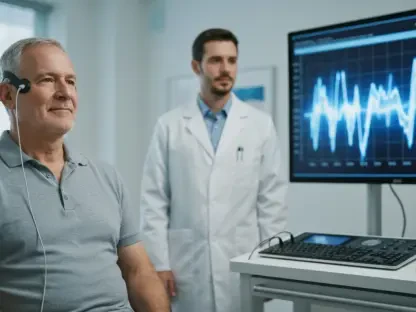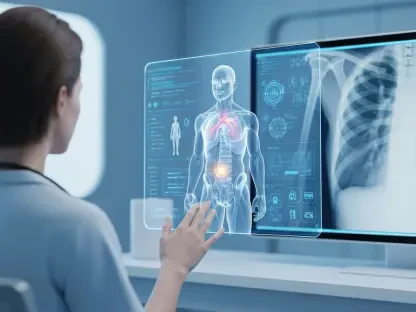What if the erratic rhythm of millions of hearts could be decoded not by a stethoscope, but by the raw power of supercomputers? Atrial fibrillation (AF), the most common type of irregular heartbeat, silently threatens lives worldwide, often leading to devastating strokes. This condition, characterized by chaotic electrical signals in the heart’s upper chambers, affects countless individuals, yet its progression remains a puzzle. High-performance computing (HPC) is stepping into this gap, offering a revolutionary lens to understand and combat this cardiac crisis. Through cutting-edge simulations, researchers are peeling back layers of mystery, revealing how fleeting glitches transform into permanent dangers.
Why Atrial Fibrillation Is a Ticking Time Bomb
Atrial fibrillation stands as a towering public health challenge, impacting over 33 million people globally, according to estimates from the National Institutes of Health. Far from a mere inconvenience, this disorder heightens the risk of ischemic stroke by up to five times, making it a leading cause of cardiovascular-related deaths. The heart’s upper chambers, or atria, lose their synchronized beat, creating a storm of irregular signals that can escalate over time if unchecked.
Traditional research methods, often limited to short-term observations in clinical settings, struggle to capture the slow, insidious shift of AF from temporary to chronic. Ethical and logistical barriers prevent long-term studies on human subjects, leaving critical gaps in understanding how the condition evolves. This pressing need for deeper insight has pushed scientists to seek innovative tools, setting the stage for technology to redefine the fight against this silent epidemic.
The Power of HPC: A Game-Changer for Heart Research
High-performance computing has emerged as a transformative force in unraveling the complexities of atrial fibrillation. By harnessing systems like the National Center for Supercomputing Applications’ Delta supercomputer and resources from the Ohio Supercomputer Center, researchers can simulate heart activity over extended periods, such as 24-hour cycles, which standard computers simply cannot handle. These simulations provide a window into the heart’s behavior that was previously unimaginable.
The speed of HPC is equally staggering, with NVIDIA GPUs and specialized CUDA code accelerating computations by up to 250 times compared to conventional machines. What once took years of processing can now be completed in weeks, fast-tracking discoveries. Beyond speed, these tools reveal intricate details, such as how heart cells adjust calcium levels in response to rapid beats, inadvertently increasing susceptibility to further arrhythmias and fueling a destructive cycle.
Real-world applications of this technology are already taking shape at institutions like Ohio State University, where teams are mapping out the long-term effects of electrical misfires in cardiac tissue. These digital models not only mimic real heart dynamics but also allow controlled experiments that bypass the limitations of physical studies. HPC is proving to be an indispensable ally in decoding the heart’s hidden chaos.
Insights from the Cutting Edge of Cardiac Science
Voices from the forefront of research bring depth to the impact of HPC on atrial fibrillation studies. Nicolae Moise, a scientist at Ohio State University’s Department of Biomedical Engineering, emphasizes the paradigm shift enabled by computational tools. In findings published in JACC: Clinical Electrophysiology, Moise notes that simulations uncover a “new temporal dimension,” allowing scientists to observe how short-term irregularities spiral into lasting damage over days or weeks.
Echoing this sentiment, the U.S. National Science Foundation’s ACCESS program underscores the critical role of advanced computing infrastructure in modern biology. Researchers involved in these projects often share a sense of awe at witnessing digital models replicate the heart’s struggles in real-time, bridging the gap between abstract data and human impact. One team member recalled the moment a simulation revealed a feedback loop in AF progression, describing it as a haunting reminder of the condition’s relentless nature. Such personal reflections ground the technological marvels in tangible stakes.
Turning Data into Action Against Atrial Fibrillation
The insights gained from HPC are not confined to academic theory; they pave the way for practical solutions to curb atrial fibrillation before it becomes irreversible. Simulations pinpoint critical windows for intervention, enabling clinicians to disrupt the self-reinforcing cycle of arrhythmias with precise timing. This data-driven approach could redefine early treatment protocols, potentially saving countless lives.
Moreover, virtual models serve as testing grounds for innovative therapies, such as drugs designed to stabilize intracellular calcium levels without the risks of immediate human trials. These digital experiments minimize uncertainties, ensuring only the most promising solutions advance to clinical stages. The ability to iterate rapidly in a simulated environment marks a significant leap toward safer, more effective treatments.
Looking beyond AF, the methodologies developed through HPC hold promise for other cardiac conditions, like sinoatrial node dysfunction. By adapting long-term simulation frameworks, researchers can explore a spectrum of heart disorders, amplifying the ripple effects of this technology. The push for early detection and novel care strategies underscores a broader mission to transform cardiovascular health through computational innovation.
Reflecting on a Computational Triumph
Looking back, the journey of integrating high-performance computing into atrial fibrillation research marked a turning point in cardiac science. The ability to simulate the heart’s intricate dance over extended timescales illuminated pathways that were once shrouded in uncertainty. Teams at Ohio State University and beyond harnessed these tools to expose the vicious cycles driving AF, laying a foundation for interventions that could halt its deadly progression.
As a next step, the scientific community must prioritize scaling these computational models, integrating them with real-world clinical data to refine accuracy. Collaboration between technologists and healthcare providers will be essential to translate digital insights into bedside solutions. Additionally, expanding access to HPC resources for smaller institutions could democratize this revolution, ensuring that more minds tackle the challenge. The battle against atrial fibrillation continues, but with supercomputers as allies, hope for a healthier future grows stronger.









